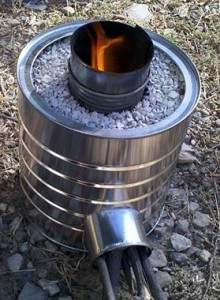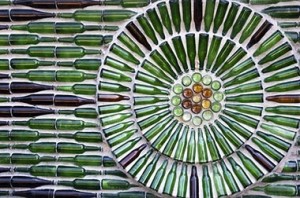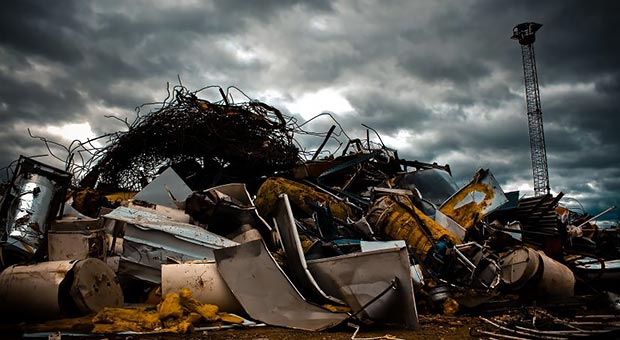Disasters come in many different forms and levels of intensity, but one common theme they all share is the destruction they leave in their wakes. Whether it’s a hurricane, tsunami, or tornado, the once civilized land will turn into a field of debris, wreckage, and trash.
When you open your shelter doors on the day after SHTF to find an apocalyptic wasteland, it will be easy to become discouraged and dismiss your surrounds as remnants of a time gone. You’ll see destroyed homes and buildings, toppled infrastructure, and heaping piles of nothing more than garbage. You might look out feel as hopeless as the area around you appears.
When every drop of water, ounce of food, and night of sleep matters, nothing can be considered waste. And that is where you have to change your mindset, starting now! If you find yourself in a survival situation, no matter how desperate you become or desolate your surroundings, eliminate the existence of trash in your mind.
You’d be surprised at the nearly endless amount of possibilities to recycle and reuse what could easily be dismissed as trash. Let’s see a few objects and materials that are likely to remain in abundance after a disaster that could be used for a variety of survival needs. But your very first step is to start thinking outside the box and unconventionally.
Until then, look at any weaknesses you may have in your home preps now, and see how you could save money by refurbishing instead of replacing. When SHTF and you, your property, and your possessions start taking some hits, you’re only choice will be to use what you find around you to make quick fixes to a multitude of problems.
Common Items and How to (Re)Use Them
1. Tin cans – Tin cans (usually made of aluminum) can be recycled into a variety of tools. They will be in abundance when SHTF, as many people will have a plenty of them after consuming their food supplies.

If you’re bugging out and camping somewhere new each night, you know how useful would be a rocket stove made from those used tin cans.
Also, tied together along a string (think the back of a newlywed’s limo), tin cans make an effective primitive alarm system.
A tin can alarm may be the difference between a run in with a hostile threat or hungry animal and a peaceful night’s sleep.
From there, the cans can be shaped back into a flat surface, essentially turning them into sheet metal.
Flattened cans could be used for paneling a variety of surfaces or cut into different tools and blades.
2. Corrugated steel – Continuing the theme of sheet metal, corrugated steel is one of the most commonly used forms of sheet metal for covering primitive structures around the world. It lasts a long time, is resistant to the elements, and is sturdy and flat. Corrugated steel can be used to help stop a leaky roof, fortify the outside of a home, or serve as the material for an entire structure.
3. Paper/Cardboard – Basically anything that comes packaged in paperboard or corrugated cardboard can be burned. It makes great kindling for fires and also acts as emergency insulation in extreme cold conditions. It would be easy to fill your house up with paper and cardboard with the amount of packaging the average household discards.
While you should consider saving a good quantity of paper and cardboard for fire kindling and other emergency uses, don’t go overboard. Also keep in mind that certain dyes, inks, and glosses can emit dangerous toxins when burned, so be careful what you put in the fire and what you use for cooking.
4. Steel drums – 55-gallon steel drums are great survival tools. They can be used as an outdoor burn barrel for both heating needs and incinerating unusable debris. They can also be fashioned into a homemade blacksmith forge, barbeque grill, or distillation pot, depending on the specs of the drum. Also consider 55-gallon plastic drums, as they can be valuable for storing potable water, fuel, and dry goods.
5. Glass containers – Glass containers and bottles can be recycled to be repurposed. Glass is one of the best vessels for keeping food and liquids sanitary and fresh, and many varieties of glass container offer more airtight lids than their plastic counterparts.

Anything with a tight-fitting lid can be reused to store both dry and wet food products, along with other various goods and supplies.
Glass jars can also be used to make candles and oil lamps for DIY low-cost lighting.
You could also use glass bottles to build houses or greenhouses, and that’s not a joke. Actually, more than 50 years ago, Alfred Heineken designed the wobo bottle which he called “the brick that holds beer”, and was used also when building bottle walls and houses.
6. Automobiles – Cars and trucks are made up of a variety of components that can be repurposed for many different survival uses. If an environmental disaster tears across a landscape, most of the cars and trucks will be put out of commission.
However, they will retain their tires, engines, interiors, and body paneling regardless of the hell they go through. Most of these parts can be reused in one way or another.
Tires can be used to build earthen walls for defense or raised planter boxes for homegrown produce. Transmission and engine oil can be used as lubricant and burned as fuel for heat and lighting. The cushioning and fabric of seats can be used in emergency shelter building or to help insulate a drafty home.
A car itself can be flipped over and left along a road or path (that is, if you can move it) as an enemy deterrent. Again, it’s all about thinking outside the box and finding a use for everything.
7. Tarps/Plastic sheeting – Tarps and plastic sheeting are often recommended for carry in any bug out bag. They make great ground coverings, serve to make a primitive tent, and can be suspended as a makeshift hammock.
Tarps/sheets can also be used to transport goods, wrap food products or fresh game, collect water, radiate heat from a fire into a shelter, or be worn as insulation or a rain poncho.
These are just a few ideas to get your brain start thinking of sustainable survival. You may live a privileged life now, but when SHTF you may have no choice but survive on what you once considered garbage.
The list above is by no means comprehensive; it only represents a few items that will likely be common after a disaster that can be repurposed to help you survive. Start to look at things in a new light now to increase your chances of making the most out of very little when SHTF.
If you have your own DIY project from garbage, speak up your mind and share it with the other preppers using the comment form below or the Contact page on our website.
This article has been written by Cody Griffin for Survivopedia.






















































































I have always considered everything as having value; some more and some less but nevertheless, valuable excepting dead bodies, of course. I can look at almost any ‘junk’ item and think of a possible use for it and agree that everyone should practice doing so in case the SHTF so they are prepared to identify its possible value.
I do not consider myself a hoarder, but some time ago I began saving glass jars and separating them as to canning use, metal lids, plastic lids, no lids, etc. If the SHTF happens, these will be both useful personal items and useful trade goods. I also did some homebrewing for several years and even though I no longer do that much, I have my equipment and I still save sturdy beer and wine bottles. My siblings call me a hoarder…
I am the same way, although, the difference between a hoarder and very smart preparedness minded person is hoarders have no organization and much of their stuff rots and they have no clue what they have, where the supplies are or how much they have. Preparedness minded people have alot but its organized and usually inventoried. We are not random buyers of everyday stuff, we are precise and resourceful.
I agree, nearly everything can be reused or repurposed. As a boy I couldn’t understand why my grandfather had so many stupid little bundles of string. Now I have a bunch of stupid little bundles of string (and I know how to use them). Also you CAN use dead bodies although using human bodies is really creepy. Even when the meat is inedible, hides and hooves can be made into glue, brains to tan hides, bones into weapons and tools, sinew (tendons) into awesome cordage. Line your fence row with skulls to deter people.
I especially like the skulls on the fence. LOL
Go on the thought of the old time root cellar, If one is industrious PRIOR to SHTF and wants an underground shelter that can also act as a bunker, consider the normal 4″ thick concrete slab of your average 24’X24′ garage floor that is reinforced with rebar. Now, go outside to the edge of the garage and envision steps or a ladder dug down approximately 6.5′ to 7′ and then under the 2-car garage (that usually gets too full of junk to park more than one car anyway) to a width of 10’X14′ … 3″ galvanized pipes bracing every 4′ around the perimeter with one on each side of the entryway of 36″ in width. Put one each at the 6′ and 10′ and 14′ mark down the center fitted tightly with 1′ square x1/2″ plate welded to each end… the bottom set on 2’square X 8″ of concrete buried to floor level. Now the roof will not be pretty, but it will be dry. The walls can be built upon an 18″ deep pier X 12″wide beam set 6″ from the wall of the excavation width to allow waterproofing from the inside as the wall is built one layer at a time till about 4″ below the garage floor and then filled in by mixed cenent around the perimeter.
The exterior entry can be dressed up as a covered ladder or steps. Electricity can be run through the garage floor through conduite and the room wired as desired.
A vent hole can be put in the slab of the garage from the top side and a metal drain cover installed to appear as a drain. A baffle can be installed below the vent/drain about 4″to 6″ below the drain to camoflage light emission.
Floor can be gradually filled in on top of 4″ of sand and 8X8 paving blocks with hand-mixed ready-mix cement to about 3″ thickness using chicken wire as a bond in place of rebar.
Use as a storm shelter/root cellar/prepper stash, etc. Imagination on camoflaging the entryway can get exciting to do, from a pile of rotted wood glued to a surface, to a niche planter box, to a fake drain, or…?
Call me crazy…you asked for comments…that’s mine.
Exterior entry can be dressed up as a covered ladder, or steps. Electricity can be run through the slab into the shelter through a pvc conduit and wired as desired. A vent hole can be put in the slab from the top side and a metal drain cover installed. A baffle can be installed below the vent/drain about 4-6″ below the train to camoflage light emission. Floor can be of patio tiles over 4″ of sand for leveling. Use as storm shelter, root cellar, prepper supplies, etc. Imagination on camoflaging entryway can get really exciting to do, from a pile of rotted wood glued to a surface, to a planter box, to a fake drain or? Call me crazy but…you asked for comments…that’s mine.
Another use for cardboard is for mulch in the compost for your home grown veggies and fruit and other plants. A friend was recently telling me to put cardboard on the bottom of my raised gardens I’m about to put in, put shredded paper on top of that, and then add the compost and garden soil, mixing them. I have been saving coffee grounds, egg shells, food leftovers, fruit rinds, and the such and am doing to mix that well, and dump it in the new raised gardens before planting which I plan to start this weekend. I think we are finally past our last danger of a freeze, about a month later than in the past (damn that global warming), and have been chomping at the bit to start the spring planting. Have about four new raised gardens to start, one from last year that I kept ground cover on which I can now dig under, and let the stuff growing from bird seed the birdies knocked out of the bird feeder go under and feed the dirt to make it richer for this spring’s crops. When I purchased some young fruit trees the young man brought me a couple bags of dried manure to toss in for fertilizer and that will go into the mix. Since I have a neighbor with two horses, the fellow behind my house has horses running loose in his fields, and there is a pasture with cattle across the street, I think by talking with the neighbors I might have a free or at least cheap source of manure. If I’m willing to gather it myself, and that is no problem whatsoever for me. I might be able to convert the store room in the car port to a chicken coop, by making a run way outside it for the chickens to get out and roam, if the landlord doesn’t mind. He has told me I can have chickens but am not sure he would want his store room full of chicken shit. The car port opens into the front yard next to the store room, so they could get out on grass and get sun light with a little chicken wire and t-poles and not that much work or money. And using mostly stuff that is here already and just repurposed. He even has old shelves in there that would make good nesting areas for hens. Very secure from predators, I could close it at night, while leaving windows open with the screens so it doesn’t get too hot.
Just cleaned out the chicken coop, and found a huge colony of meal worms. I shoveled it into a couple 5 gallon buckets, and it is proving to be super food for our new baby chickens for this season. If regular feed is unavailable, be sure to check the old chicken poop for bugs that would serve as food for new chickens – a convenient recycling program.
My husband made a rope, and a very strong one by cutting the plastic bags from the grocery store longways, took 3 of them and started braiding them. He pulled himself up with them and he is no small man!!!
Great idea for binding objects together although they degrade fast in sunlight and are probably going to be phased out soon.
I have found out that the can openers that use the side of the can that doesn’t leave a sharp edge. Make a good reseal able container. There are many shapes and sizes.
WHY does everyone assume a car has no value except as parts for other projects?
Remove engine and transmission, add tongue to hitch up horses have coach for family to ride in instead of being out in the weather. It already has brakes.
You’re 100% correct not to mention its worth as clean and dry shelter.
WHY does everyone assume a car has no value except as parts for other projects?
Remove engine and automatic transmission and put in floor and have a second trunk, add tongue to hitch up horses have coach for family to ride in instead of being out in the weather. It already has brakes very helpful for controlling runaway horses and down hill speed. Manual transmission (use 1st gear) put pulley on and use to run generator charge battery and have lights.
A car can also be used as an “incubator” for seedlings when bugged out or if just sitting in driveway. Be sure to crack the windows a bit, it gets hot fast even in lower temps
You can also dry herbs, etc. in a car that sits. It only takes a couple of days and with the windows up, no bugs.
One of the first SHTF type memories I have is reading the Hardy Boys survival manual. ( Which I heartily recommend for kids) 7 short stories on different scenarios. http://www.amazon.co.uk/The-Hardy-Boys-Survival-Handbook/dp/0001605585 reminded of it here because there is one where they are stuck in the desert and cannabalize a car for survival; although I would recommend updating it as in modern cars there will me contaminants like anti-freeze in the radiator.
you can fix a leak in a car radiator with a bar of soap its as easy as its sounds u just plug it up I have been almost studying shtf and recycling to save ur life in a situation like this(Im 15 BY the way) it just disappoints me knowing so meany people could be saved (lets say in an emp) with this kind of simple knowledge
Anybody that has parents or grandparents, still living that went through the depression, needs to learn as much as they can from them.